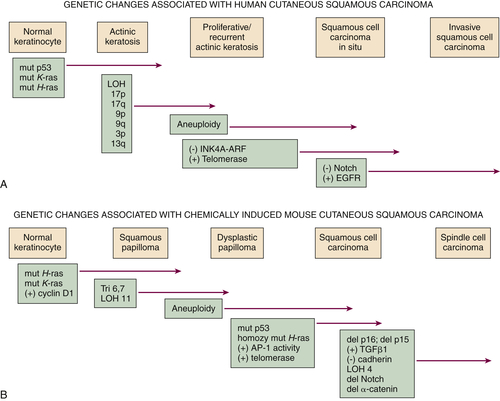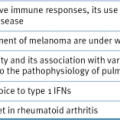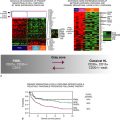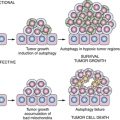In addition to these highly penetrant hereditary syndromes, genome-wide association studies are identifying new loci that confer increased risk for either BCC or SCC, although the mechanistic details remain. Single-nucleotide polymorphisms (SNPs) within several well-characterized pigmentation loci—including MC1R (melanocortin 1 receptor) and OCA2 (oculocutaneous albinism II)—and a potential pigmentation locus IRF4 (interferon regulatory factor 4) show linkage to increased risk for both BCC and SCC NMSC. 4–6 Other SNPs on 6p25 and 13q32 near the EXOC2 and UBAC2 genes also show linkage with increased risk of SCC, 6 whereas two functional SNPs in the nucleotide excision repair gene ERCC6 are significantly associated with increased risk of BCC. A history of NMSC is also associated with increased risk for subsequent noncutaneous malignancies, and a previous SCC is associated with poor prognosis for cancers of the lung, colon, rectum, and breast and for non-Hodgkin lymphoma. Although the genetic basis of this is currently unknown, GWAS studies of patients with NMSC and a noncutaneous malignancy will likely reveal additional loci conferring risk for cancer for which the appearance of NMSC may be a signal.
Basal Cell Carcinoma
BCC is a very common, slow-growing, locally invasive tumor that typically presents as a pink or pearly papule with superficial telangiectasia and occasional ulceration. BCC precursor lesions have not been identified, there is no evidence of neoplastic progression, phenotypic diversity even within the same tumor is common, and metastases are exceedingly rare. Chromosomal losses involving 9q mark both sporadic and inherited BCCs, leading to the discovery of mutations in PTCH1, 3 a homologue of the Drosophila ptc gene involved in embryonic development.
Ptch1 is a 12-pass transmembrane receptor for Sonic hedgehog (Shh), a secreted ligand involved in the proliferation and patterning of multiple tissues and organs during embryogenesis. Shh binds to Ptch and alleviates Ptch-mediated repression of Smo on responding cells (reviewed in Reference 1). Active Smo enters the primary cilium, where it functions to modify the expression and structure of a family of Gli transcription factors to alter the expression of Shh target genes. The complexity of the pathway is enhanced by the presence of additional vertebrate homologues of Drosophila proteins, fused (a serine-threonine kinase), suppressor of fused (SuFu) that binds to Gli proteins, Cos 2 (Kif7), and Iguana (Dzip1), with SuFu, Cos2, and Iguana serving as inhibitors of Gli signaling. 1 Activation of the Shh pathway upregulates Gli1 and Ptch1, and these serve as markers for physiologic and pathologic Shh signaling. In human BCCs, inactivating mutation or deletion of PTCH1 results in constitutive signaling independent of SHH. In addition to loss-of-function PTCH1 mutations, gain-of-function (oncogenic) SMO mutations have been found in some BCCs where PTCH1 appears to be normal. PTCH1 or SMO mutations are implicated in about 80% of BCCs, whereas hedgehog signaling is active in all BCCs. Thus, additional mechanisms must exist for uncontrolled activation of this pathway. Rare mutations in SuFu have been reported in BCCs, and other syndromes are known to predispose to BCC, but the genetic bases for these have not been delineated. Although mutations in p53 have been found in up to 50% of BCCs , most lesions fail to exhibit the genomic instability associated with other cancers where p53 function is compromised, 7 and the presence or absence of p53 mutations does not alter the histological phenotype, although loss of p53 function facilitates the eruption of BCC in animal models.
Gli activation is the driving force for tumor development in the setting of constitutive Hedgehog signaling. The three mammalian Gli proteins are zinc finger proteins that bind to a 9bp canonical binding site in the promoters of target genes following activation of hedgehog signaling (reviewed in Reference 1). The regulation of Gli activity by hedgehog signaling is complex; Gli2 and Gli3 proteins have both transcriptional repressor and activating domains, whereas Gli1 is strictly a transcriptional activator. Much of the regulation of Gli proteins is post-translational. Gli3 processing primarily generates a transcriptional repressor, whereas processed (phosphorylated) Gli2 is ubiquitinated and degraded. Shh signaling suppresses processing and degradation of Gli2 and stabilizes its transcriptional activation function. Genetic ablation studies in mice have displayed the consequences of Gli activity in vivo. Gli1-null mice are without a phenotype, whereas the developmental defects and impaired hair follicle growth caused by ablation of Gli2 indicate that Gli2 is the downstream effector of the Hh pathway. 8 Disruption of Gli3 produces a phenotype consistent with hedgehog activation, validating its action as a repressor of the pathway.
Genetically altered mouse models provide experimental evidence linking the hedgehog pathway to human BCC. 9 Targeting SHH or an activated SMO mutant to the epidermis and hair follicles upregulates Shh target genes and produces basal cell–like proliferations in newborn mouse skin. Overexpression of SHH in human keratinocytes followed by grafting onto severe combined immunodeficiency (SCID) mice produced BCC-like changes as well. Mouse models in which Ptch gene function has been disrupted develop microscopic hair follicle–derived proliferations, with the appearance of a variety of macroscopic skin tumors, including BCCs, following exposure to ionizing or UV radiation. 10 Mice with skin targeted overexpression of human GLI1 or mouse Gli2 develop multiple BCCs or other tumors arising from hair follicles. The Hh pathway is regulated through primary cilia, present on most mammalian cells, which acts as an organizing structure for signaling and is essential for proteolytic processing of Gli proteins to activator and repressor forms. Inactivation of Kif3a, an essential component of the anterograde intraflagellar transport motor, blocks formation of BCC in mice expressing the activated form of SMO, but accelerates tumor formation driven by activated Gli2. Thus cilia play a dual role in both activating and inhibiting Shh signaling and tumorigenesis.
Taken together, these findings strongly support the concept that deregulated Shh signaling is central for BCC development. When Gli2 is targeted to mouse epidermis and hair follicles conditionally, BCCs develop from overexpression and regress when expression is discontinued. On reexpression of Gli2 in this model, tumors reemerge from a small residual population of precursor cells. What remains unclear is the identification of the hedgehog target genes downstream from Gli that are essential for BCC formation. A number of candidates have been reported, including several cyclins, E2f1, N-Myc, Pdgfr, Bcl2, BEG4, FOXM1, and FOXE1, Mim, Hhip, Snail, Ptch1, and Gli1 (Figure 41-1 ), but definitive studies on these genes are lacking. In both human and mouse BCC the Wnt pathway appears dysregulated due to elevated expression of β-catenin, and blockade of Wnt signaling in mice blocks hedgehog-driven tumor growth. Crosstalk between hedgehog and EGFR signaling is synergistic for BCC induction in animal models, suggesting that EGFR inhibitors could have a therapeutic role in the clinic. Small-molecule inhibitors of SMO have been developed based on the natural product cyclopamine, which causes BCC regression in animal models. In recent Phase III clinical trials, the SMO inhibitor vismodegib has caused significant tumor regression in patients with advanced sporadic BCC 11 and regression of preexisting lesions and prevention of new lesions in Gorlin syndrome patients. 12 Vismodegib was approved by the U.S. Food and Drug Administration (FDA) in January 2012 for adult patients with recurrent locally advanced or metastatic BCCs or who are not candidates for surgery or radiation. Other inhibitors are likely to follow, although target-based side effects may be an inherent limitation for long-term treatment. Because the Hedgehog pathway is aberrantly activated in malignancies arising in several internal organs, 1 these inhibitors are likely to have a significant impact on the treatment of a broad range of human neoplasms.

Figure 41-1 Simplified model depicting hedgehog signaling in skin physiology and BCC pathogenesis The major site of action for sonic hedgehog (SHH) is the hair follicle (HF). In resting hair follicles, SHH is not expressed, and PTCH1 dampens SMO activity. Under these conditions, Gli transcription factors are unstable and degraded. In addition, posttranslational processing of GLI2 and GLI3 processing yields a transcriptional repressor that suppresses SHH target gene expression. When SHH expression increases during HF growth (anagen), PTCH1 is inactivated, SMO is phosphorylated by casein kinase 1 and protein kinase A, and active SMO upregulates Gli proteins by posttranslational mechanisms, leading to accumulation of Gli transcriptional activators. One target of Gli transcription is PTCH1, which serves as a negative feedback on this reversible pathway. In BCC initiation, PTCH1 is genetically deleted (or SMO is mutationally activated to SMO∗), and the pathway is irreversibly activated. Gli2 appears to be the major driving factor to upregulate a number of effectors responsible for the neoplastic phenotype, including GLI1, MYCN, BCL2, SFRP1, MIM, HHIP, CCND1, SNAIL, FOXE1, and FOXM1.
Cutaneous Squamous Cell Carcinoma
Cutaneous SCC frequently presents as a firm, pink papule or nodule, with a conspicuous hyperkeratotic surface. Although SCCs represent only about 20% of nonmelanoma skin cancers, they are invasive and occasionally metastasize (1% to 2%). SCC is more frequent with higher cumulative sunlight exposure and as cancers associated with specific occupational exposures (coke oven and petroleum oil workers). There is roughly a 25- to 200-fold increase in SCC incidence in immunosuppressed organ transplant recipients, with a reversal of the BCC-to-SCC ratio; these tumors are more aggressive, occur in multiple locations within one patient, and are associated with increased morbidity and mortality. Conversely, a drug that activates local innate and adaptive immune responses through TLR-7 (imiquimod (1-(2-methylpropyl)-1H-imidazo[4,5-C]quinolin-4-amine) is highly effective in treating BCC, SCC, and its precursor lesion, actinic keratosis (AK). 13 Cutaneous SCC is usually preceded by a benign hyperproliferative-hyperkeratotic AK (Figure 41-2 , A). These are sunlight-induced clonal lesions that frequently harbor p53 mutations, particularly at codon 278 or other codons of the DNA binding domain of p53 that contain dipyrimidine sites. AKs often exhibit chromosomal changes, particularly loss of heterozygosity (LOH) at 3p, 13q, 17p, 17q, 9p, and 9q. Such changes are less frequent in SCC, clouding the direct relation of AK to SCC. However, the frequency of evolution of AK to SCC is very low (0.1% to 10%), suggesting there may be a high-risk AK group with relevant genetic changes not yet documented. Activating mutations in the K-RAS or Ha-RAS gene are detected in approximately 10% of AK and SCC, and the RAS pathway is activated by non-mutational mechanisms in a much larger fraction of SCCs. Inactivating mutations or epigenetic silencing of p16(INK4a) and activation of telomerase are other pathways associated with SCC development. Constitutive activation of the EGF receptor (EGFR) by amplification or increased expression of ligands with the formation of an autocrine loop is a frequent finding in SCC. Gene expression arrays have revealed several other genes whose expression is characteristic of SCC, but experimental validation of a causal relation remains to be determined.

Figure 41-2 Genetic changes associated with (A) human cutaneous squamous carcinoma and (B) experimental mouse skin squamous carcinoma The multistage evolution of invasive squamous cell cancer is depicted schematically with frequently associated genetic changes detailed here. Although many common pathways exist in the two species, current understanding places p53 mutations early in human SCC development and ultraviolet light–induced mouse skin SCC (not shown), but p53 mutations occur late in chemically induced mouse skin SCC associated with malignant conversion. Increased activity of telomerase (deletion of inhibitor) or EGFR tyrosine kinase (gene amplification) and decreased signaling in the Notch pathway (mutation) may also result from epigenetic changes, as in the case of upregulation of EGFR ligand expression in mouse SCC development. This figure is modified from Dlugosz A, Merlino G, Yuspa SH. Progress in cutaneous cancer research. J Invest Dermatol Symp Proc 7:17-26, 2002, with permission of the Journal of Investigative Dermatology.
Constitutive activation of NFκB signaling is common in SCC, 14,15 and this is associated with upregulation of specific NFκB target genes associated with altered proliferation, invasion, angiogenesis, and inflammation. NFκB hyperactivation is a known inducer of cylindromatous skin tumors, because homozygous deletions of the CYLD gene, encoding a deubiquitinase that negatively regulates the NFκB pathway through targets such as TRAF2 and BCL-3, has been identified as the basis for familial cylindromatosis (see Table 41-1). Homozygous deletion of CYLD in mice increases susceptibility to squamous skin tumors. However, studies with genetically modified human keratinocytes grafted to nude mice suggest that inhibition of NFκB together with activation of the RAS oncogene is sufficient to convert normal keratinocytes into SCC, and a similar result has been obtained in the skin of transgenic mice. This controversy is unsettled at this time.
To prove causal relations among the various associations made by studying human SCC, model systems using human and mouse keratinocytes in culture and animal models in vivo have been developed. The classical carcinogenesis model to induce SCC on mouse skin involves a limited application of a mutagenic agent such as a chemical carcinogen or UV light that “initiates” the cancer process in a subset of cells, followed by repeated applications of a nonmutagenic agent such as a phorbol ester that provides a microenvironment favorable for the clonal outgrowth of the initiated population. Tumor development proceeds through predictable stages, with the early emergence of benign squamous papillomas, the murine equivalent of AK, some of which progress to invasive SCC, mimicking human SCC with a low metastatic rate (see Figure 41-2, B). In some cases SCC will evolve into a more aggressive spindle cell cancer. This model has illuminated the genetic and biochemical changes that are permissive for SCC development under controlled experimental conditions. Heterozygous activating Ras gene mutations are sufficient to “initiate” the target cells and produce squamous papillomas, and this is coupled to constitutive activation of the EGFR through overexpression of EGFR ligands (see Figure 41-2, B). Papillomas form spontaneously in transgenic mice overexpressing ErbB2 and TGFα in epidermis, and papilloma formation is reduced in mice where EGFR or SOS is ablated. Furthermore, tumor formation is completely inhibited in mice lacking the Stat3 gene, a downstream target of the EGFR. The clinical relevance of this pathway is highlighted by the effectiveness of anti-EGFR drugs in head and neck SCC patients. The relevance of the RAS pathway in human skin cancer is emphasized by the development of multiple cutaneous SCC and keratoacanthoma expressing Ha-RAS mutations in melanoma patients treated with the BRAF V600E inhibitor vemurafenib. 16 This drug also enhanced chemical carcinogenesis on mouse skin through stimulation of MAPK activity. Inactivation of PKCδ is also essential for papilloma development in mouse skin. PKCδ is inactivated by c-Src–mediated tyrosine phosphorylation in initiated mouse keratinocytes, whereas in human skin tumors the expression of PKCδ transcripts is greatly reduced. Transgenic mice overexpressing PKCδ in the skin do not form skin tumors. TGFβ plays a dual role in experimental SCC development, suppressing premalignant progression to SCC while enhancing phenotypic progression from SCC to a spindle cell phenotype. 17 However, topical inhibitors of the TGFβ type I receptor suppress papilloma formation, suggesting that TGFβ signaling is important in tumor outgrowth. Inactivation of p53 enhances malignant conversion of papillomas to SCC in chemical carcinogenesis but is an earlier event in UV light–induced skin carcinogenesis in both mice and humans. Members of the AP-1 transcription factor family also play a dual role in experimental skin tumor development, where c-Jun is essential for papilloma and c-Fos is essential for SCC development. Inhibition of AP-1 activity after the formation of benign papillomas prevents malignant conversion.
In contrast to murine models for BCC, the development of techniques to genetically alter mice greatly expanded the array of genes and pathways that influence SCC development on the skin (Table 41-2 ), indicating a much more complex pathogenesis. Pathways and genes that can influence SCC development and progression to spindle cell tumors in mice include cyclin D1, ornithine decarboxylase, p16(ink4A), p15(ink4A), p63, E-cadherin, and TGFβ1, and these are frequently altered in human SCC. In several model systems, genetic alterations have resulted in the spontaneous development of SCC in the absence of a precursor lesion. For example, mice ablated for Notch or β-Catenin rapidly form SCCs even in the absence of carcinogenic exposure, and ablation of Notch in epidermis promotes tumor formation by creating a barrier defect and promoting inflammation. 18 In fact, loss of function Notch mutations is frequently found in cutaneous SCC. 19 Furthermore, clinical trials of γ-secretase inhibitors for the treatment of Alzheimer’s disease have been discontinued because of emergence of NMSC. 20 γ-Secretase is required for the activation of intracellular Notch action.
Defining the Cell of Origin for Cutaneous Cancers
Genetic profiling of both SCC and BCC indicate a monoclonal origin. However, the multiplicity of epithelial tumor phenotypes in skin (see Table 41-1) and the divergent phenotypes within each suggest that either multiple target cells exist within the complex compartmentalization of the integument or that specific genetic lesions or tumor microenvironments acting on a multipotential target cell determine tumor phenotype and malignant potential. 21,22 Both human and murine skin contains several types of stem cells within different locations in the epidermis and hair follicle that maintain discrete epidermal compartments, with stem cells within the bulge region of the hair follicle the best characterized. 22 Gene expression analysis of isolated murine hair follicle stem cells and analysis of genetically altered mice has revealed specific gene expression patterns and signaling pathways that define stemness, and Lgr6+ cells residing above the follicle bulge may mark stem cells capable of generating all three self-renewing compartments of the epidermis. 23
Stay updated, free articles. Join our Telegram channel

Full access? Get Clinical Tree








